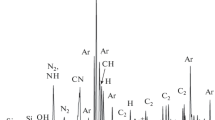Abstract
A plasma deposition technique for amorphous aluminum oxide films is discussed. A 450 kHz or 13.56 MHz power supply was used to generate the plasma and the deposition of the film was achieved at low plasma power using trimethyl-aluminum and carbon dioxide reactant sources. It has been found that for the low frequency plasma the growth is strongly dependent upon TMA concentration, indicating that the growth process is mass transport limited. On the other hand using the 13.56 MHz discharge results in a surface controlled growth rate. An increase in the deposition temperature up to 300° C makes the films more dense and lowers their etching rate. FTIR and ESCA measurements showed that oxidation is only completed with high CO2 concentrations and a deposition temperature above 250° C. The dielectric films were found to have a dielectric constant in the range 7.3=2-9 and a refractive index between 1.5–1.8 depending upon deposition conditions.
Similar content being viewed by others
References
R. S. Nowicki, J. Vac. Sci. Technol.14 127 (1977).
R. S. Ehle, B. J. Baliga and W. Katz, J. Electron. Mater.12, 587 (1983).
J. Saraie, J. Kwon and Y. Yodogawa, J. Electrochem. Soc.132, 890 (1985).
H. Katto and Y. Koga, J. Electrochem. Soc.118,1619 (1971).
A. H. Bailey, D. A. Darbshire, A. P. Overbury, C. W. Pitt and J. Newton, Vacuum36, 139 (1986).
R. Solanki, W. H. Ritchie and G. J. Collins, Appl. Phys. Lett.43, 454 (1983).
M. Minakata and Y. Furukawa, 25th Electronic Materials Conference, Burlington, VT, USA, June 23, 1983.
A. Talébian, Thèse de 3ème Cycle, Université de Nantes, Novembre 1986.
R. G. Frieser, J. Electrochem. Soc.113, 357 (1966).
L. H. Hall and W. C. Robinette, J. Electrochem. Soc.113, 1624 (1971).
J. A. Aboaf, J. Electrochem. Soc.9, 948 (1967).
M. T. Duffy and W. Kern, R.C.A. Rev.31, 754 (1970).
D. J. Ehrlich and R. M. Osgood Jr., Chem. Phys. Lett.79, 381 (1981).
K. J. Laidler, Chemical Kinetics, McGraw-Hill, New-York, 1965.
Y. Catherine and A. Pastol, European Materials Research Society E-MRS Meeting, Strasbourg-France, June 2–5 (1987).
R. P. Chang and S. Darack, Appl. Phys. Lett.42, 272 (1983).
K. Nakamoto, infrared Spectra of inorganic and coordination compounds, Wiley, New York, 1963, pp. 104–211, 213–217.
R. P. H. Chang, S. Darak, C. C. Lane, D. Aliara and E. Ong, J. Vac. Sci. Technol.B1, 935 (1983).
Y. Zhiquiang and G. L. Harding, Thin Solid Films120, 81 (1984).
Author information
Authors and Affiliations
Rights and permissions
About this article
Cite this article
Catherine, Y., Talebian, A. Plasma deposition of aluminum oxide films. J. Electron. Mater. 17, 127–134 (1988). https://doi.org/10.1007/BF02652142
Received:
Revised:
Issue Date:
DOI: https://doi.org/10.1007/BF02652142



